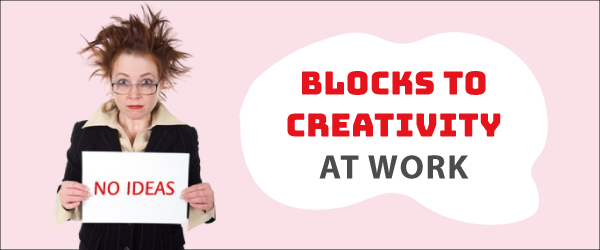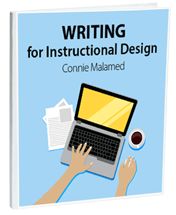
Designing learning experiences can be demanding, particularly if you’re devoted to creative strategies that engage your audience. At times, however, it feels as though the well is dry and your creative flow has disappeared. You may have blocks to creativity, of which there are many. If you can identify the type of block, you can overcome it.
Creativity Defined
Creativity manifests in many ways, making it difficult for psychologists to study, research, and define it. Think of how creativity informs technical innovation, artistic expression, scientific endeavors, individual life choices, problem-solving, and gameplay—such a variety of domains!
Although psychologists don’t agree on a definition, there is a general sense that creativity involves the production of a new and valuable idea, action, or object. The value of a creative endeavor depends on the circumstances or cultural context. Find out more about the stages of creativity.
You may generate creative solutions to life’s problems every day without even realizing it. But you can find yourself stuck when you need to produce creative work on demand.
Creative Obstacles
In the book Conceptual Blockbusting, author James Adams presents four categories of common obstacles that block creativity:
- Perceptual blocks
- Emotional blocks
- Cultural and environmental blocks
- Intellectual and expressive blocks.
Understanding these blocks is the first step to conquering them.
1. Perceptual Blocks
There are many forces that influence our perceptions, including expectations, bias, cultural values and past experience. This causes us to see the world through our own filters and our own stereotypes. When perceptual blocks deter us from perceiving a problem clearly, it hampers creative problem-solving. According to Adams, we often reject evidence that violates our preconceived ideas.
How can we solve a problem when we aren’t perceiving it accurately? For example, suppose an instructional designer harbors false ideas about audience members due to stereotyping. This may create a misperception of their work performance problems, which would interfere with creative problem-solving strategies.
This happened to me several years ago when I was told by the sponsor of a course for physicians that the audience members preferred lectures and did not like games. He said this was what they were used to in medical school and continuing education courses. However, as I got to know the audience members, I discovered that although they might not have time for games, they were willing to learn through simulations of real-life events and problem-solving. This approach was much more engaging.
 2. Emotional Blocks
2. Emotional Blocks
Many people are uncomfortable with taking risks and fear making mistakes. Much of our traditional educational system is based on coming up with one correct answer. When a person lacks confidence or fears rejection, it can hinder the free flow of creative juices.
We may also suffer from other emotional blocks, such as:
- A preference for making judgments too soon rather than a focus on generating many ideas first
- An intolerance for ambiguity
- An inability to take the time to allow ideas to incubate
According to Adams, these emotions can interfere with our ability to ideate, manipulate, and explore new ideas. This matches what brain research demonstrates: that signals from the senses go directly and quickly to the brain’s emotional centers even before one can analyze a situation rationally. As the emotional centers in the brain create an automatic response, it can choke creativity.
3. Cultural Blocks to Creativity
Conceptual Blockbusting points out that we are part of many cultures related to age, ethnicity, religion, values, and the broader culture. We absorb underlying beliefs from our cultural interactions that can interfere with creative innovation. For example, it’s common for adults to think that play and fantasy are for children, that logic is more important than feeling, and that doing nothing (while ideas incubate) is lazy. These are the types of messages that infiltrate our minds in a slow drip. These are the types of messages that can block creativity.
Psychologists say creativity thrives in a permissive environment, yet many people spend their days in a workplace that frowns upon innovative thinking. Furthermore, the traditional workplace is often filled with distractions interrupting your creative flow. In some workplaces, competition between employees, autocratic bosses, or a lack of team cooperation can bury creative notions. These are the environmental blocks we must overcome. For suggestions, see How Creative is Your Environment?
4. Intellectual and Expressive Blocks
Intellectual and expressive blocks may occur when approaching a problem from only one perspective. Sometimes, a problem is in one domain but must be solved in another. If you are inflexible in your thinking, this could block the generation of creative solutions.
For example, suppose your client insists on using video to demonstrate a process, but you can’t figure out how to stage the whole thing. Or there isn’t enough budget to pay for a video production. Maybe the solution is to use another type of media in another domain. Perhaps the process can be demonstrated with a series of sketches or photographs, and mocking up a prototype will convince your client otherwise. Cognitive flexibility lets you cross domain boundaries.
I believe every person is born with the potential to engage in a creative life. Various societal practices well as life circumstances can work against this potential. Creativity is not only important when designing training, but it enriches our lives and the lives of others. Creative acts help culture and society evolve. For more on improving your creativity, listen or download the transcript for this conversation with a professor of creativity: How to Develop Your Creativity.
Reference:
Adams, James L. Conceptual Blockbusting, 2019, Basic Books, 5th Edition.


[…] Is Your Creativity Blocked? A quick little rundown on some common creativity stumbling […]